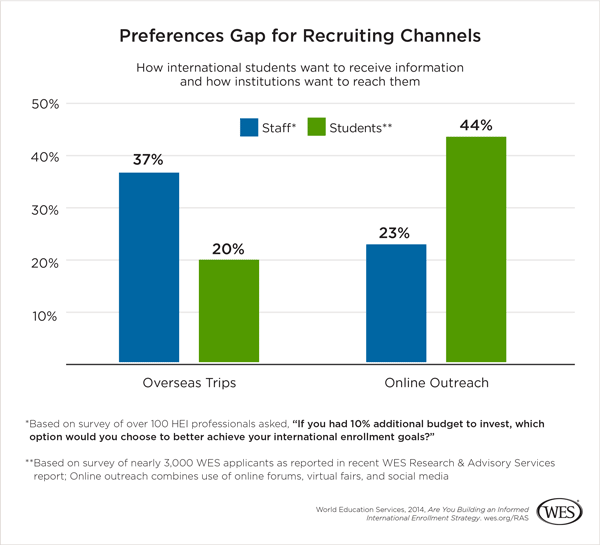Ian Wright, Research & Advisory Services, WES
Many international recruitment professionals still place a greater value on high-cost, overseas recruitment than on “armchair” strategies that take advantage of data analytics, technology and online resources. When petitioning for next year’s budget, professionals with such a “20th Century” strategy are increasingly likely to face resistance from institutions who are reassessing “what’s always worked” with shrinking bottom lines and data-supported solutions.
For example, WES surveyed professionals from higher education institutions (HEIs) participating in our six-part webinar series last fall, identifying what their preferred strategies would be if they had additional funding to spend on international recruiting,1 [1] and comparing those thoughts to the results of our applicant survey.2 [2] Consistently, the most popular area for investing additional resources was in overseas trips (37%), with significantly less interest in online outreach efforts (23%).
By contrast, our recent WES Research & Advisory Services report [3] identified the tools and strategies international students use when researching U.S. study options. Student interest focused heavily on website clarity (total cost of attendance, support services, and marketing materials in their native tongue that focused on the institution’s unique characteristics) and online access to admissions officers, current students, and international alumni.
These findings show that many HEIs may not be following market-specific segmentation strategies, or may not be as focused on the evolving needs and behaviors of prospective international students in the context of online media. To address this gap between where university enrollment professionals want to invest their resources and the platforms most often utilized by current international applicants, we recommend an analytics-driven approach to the changing needs of different student segments.
Universities actively engaged in collecting and crunching their own data on international inquiries and enrollment are beginning to invest more strategically in student and alumni “brand ambassadors” (21% of respondents). They are also repositioning their investment in online fairs and social media to better reflect the yield rate from these platforms compared to an “international-friendly” website. A strategic, intentional approach to enrollment management helps HEIs struggling to meet the challenge of finding efficiencies and optimizing their return on investment in a more competitive and austere international recruiting environment.
To form effective international enrollment strategies, student segmentation can help HEIs better understand the behaviors and preferences of international students, and promote the design of targeted recruitment strategies.
1. [5] Based on survey of over 100 HEI professionals asked, “If you had 10% additional budget to invest, which option would you choose to better achieve your international enrollment goals?” Overseas recruitment trips; Online outreach efforts (e.g. virtual fairs and social media); International students/alumni ambassador program; Use of recruitment agents; Information technology systems (e.g. CRM)
2. [5] Based on survey of nearly 3,000 WES applicants as reported in recent WES Research & Advisory Services report; Online outreach combines use of online forums, virtual fairs, and social media
Previous Mobility Monitors
WES in the News
- Campuses Focus More on Meeting International Students’ Needs [9], The Chronicle of Higher Education
- ETS Sees Big Jump in Number of GRE Tests Taken in India [10], The Chronicle of Higher Education
- Record Number of Foreign Students to Enrol in 2014 [11], University World News


